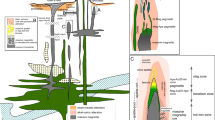Abstract
Celadonite from the northwestern Mojave Desert area of California was examined by detailed Mössbauer spectroscopy at temperatures from 10 K to 400 K. In addition to the predominant Fe3+ doublet with isomer shift δ∼0.4 mm s−1 and quadrupole splitting Δ ∼ 0.4 mm s−1, another Fe3+ doublet with δ∼ 0.4, Δ∼1.2 mm/s and two Fe2+ doublets with δ∼1.1, Δ ∼ 1.7, 2.7 mm s−1 at 300 K were distinguished. The minor Fe3+ component is ascribed to dehydroxylated surface sites. Most of the remaining Fe(∼90%) is M2 cis-OH octahedral in an ordered M+−M2+ array. However, about 10% is M1 trans-OH Fe2+. Isomer shift vs. T gives Debye temperatures of 570 K for Fe3+ in M2 and 380 K for both Fe2+ sites, indicating greater vibrational freedom for Fe2+. Quadrupole splitting Δ vs. T for Fe2+ gives a valence electronic energy splitting of 760 cm−1 between the ground and first excited state for M2. The M1 sites have a more drastic variation in Δ vs. T which indicates not only a lower first excited state but a rhombic distortion at these sites. A proposed explanation is a neighboring M2 site vacancy. The soil clay formed from this celadonite, which is mostly Fe-rich smectite, was also studied by Mössbauer spectroscopy. About half the Fe2+ has been oxidized in the clay, but the isomer shifts and quadrupole splittings are essentially the same as in the original celadonite. A texture orientation in the clay absorber was detected by measuring the absorber at 55° to the source radiation. This texture effect produces asymmetric doublets in the usual 90° measurement.
Similar content being viewed by others
References
Amarasiriwardena DD, DeGrave E, Bowen LH, Weed SB (1986) Quantitative determination of aluminum-substituted goethitehematite mixtures by Mössbauer spectroscopy. Clays Clay Miner 34:250–256
Ballet O, Coey JMD (1982) Magnetic properties of sheet silicates; 2:1 layer minerals. Phys Chem Minerals 8:218–229
Bancroft GM, Brown JR (1975) A Mössbauer study of coexisting hornblendes and biotites: quantitative Fe3+ /Fe2+ ratios. Am Mineral 60:265–272
Bernas B (1968) A new method for decomposition and comprehensive analysis of silicates by atomic absorption spectroscopy. Anal Chem 40:1682–1686
Cardile CM, Brown IWM (1988) An 57Fe Mössbauer spectroscopic and X-ray diffraction study of New Zealand glauconites. Clay Miner 23:13–25
Dainyak LG, Drits VA (1987) Interpretation of Mössbauer spectra of nontronite, celadonite, and glauconite. Clays Clay Miner 35:363–372
Dainyak LG, Bukin AS, Drits VA (1984) Interpretation of Mössbauer spectra of dioctahedral Fe3+-containing layer silicates. III. Celadonite. Sov Phys Crystallogr 29:186–191
DeGrave E, Geets S (1979) 57Fe Mössbauereffektmetingen aan Belgische glauconieten. Bull Belg Ver Geol 88:237–251
DeGrave E, Vanleerberghe R, Verdonck L, DeGeyter G (1984) Mössbauer and infrared spectroscopic studies of Belgian chloritoids. Phys Chem Minerals 11:85–94
DeGrave E, Vandenbruwaene J, Elewaut E (1985) An 57Fe Mössbauer effect study on glauconites from different locations in Belgium and northern France. Clay Miner 20:171–179
DeGrave E, Vandenbruwaene J, Van Bockstael M (1987) 57Fe Mössbauer spectroscopic analysis of chlorite. Phys Chem Minerals 15:173–180
Dyar MD (1987) A review of Mössbauer data on trioctahedral micas: evidence for tetrahedral Fe3+ and cation ordering. Am Mineral 72:102–112
Ferrow E (1987) Mössbauer effect and x-ray diffraction studies of synthetic iron bearing trioctahedral micas. Phys Chem Minerals 14:276–280
Heberle J (1971) The Debye integrals, the thermal shift and the Mössbauer fraction. In: Gruverman U (ed) Mössbauer effect methodology, vol 7. Plenum Press, New York, pp 299–308
Heller-Kallai L, Rozenson I (1980) Dehydroxylation of dioctahedral phyllosilicates. Clays Clay Miner 28:355–368
Heller-Kallai L, Rozenson I (1981) The use of Mössbauer spectroscopy of iron in clay mineralogy. Phys Chem Minerals 7:223–238
Ingalls R (1964) Electric field gradient tensor in ferrous compounds. Phys Rev 133:A787-A795
Johnston JH, Cardile CM (1987) Iron substitution in montmorillonite, illite, and glauconite by 57Fe Mössbauer spectroscopy. Clays Clay Miner 35:170–176
Kotlicki A, Szczyrba J, Wiewiora A (1981) Mössbauer study of glauconites from Poland. Clay Miner 16:221–230
McConchie DM, Ward JB, McCann VH, Lewis DW (1979) A Mössbauer investigation of glauconite and its geological significance. Clays Clay Miner 27:339–348
Murad E (1987) Mössbauer spectra of nontronites: structural implications and characterization of associated iron oxides. Z Pflanzenernähr Bodenk 150:279–285
Pound RV, Rebka GA Jr (1959) Gravitational red-shift in nuclear resonance. Phys Rev Lett 3:75–76
Raclavsky K, Sitek J, Lipka J (1973) Mössbauer spectroscopy of iron in clay minerals. Proc. 5th Internat. Conf. Mössbauer Spectroscopy, Bratislava, pp 368–371
Reid DA, Graham RC, Edinger SB, Bowen LH, Ervin JO (1988) Celadonite and its transformation to smectite in an Entisol at Red Rock Canyon, Kern County, California. Clays Clay Miner 36:425–431
Rolf RM, Kimball CW, Odom IE (1977) Mössbauer characteristics of Cambrian glauconite, central USA. Clays Clay Miner 25:131–137
Rossman GR (1984) Spectroscopy of micas. In: Bailey SW (ed) Reviews in mineralogy, vol 13. Micas, Mineralogical Soc Am, pp 145–181
Rozenson I, Heller-Kallai (1978) Mössbauer spectra of glauconites reexamined. Clays Clay Miner 26:173–175
Slonimskaya MV, Besson G, Dainyak LG, Tchoubar C, Drits VA (1986) Interpretation of the IR spectra of celadonites and glauconites in the region of OH-stretching frequencies. Clay Miner 21:377–388
Townsend MG, Longworth G, Roth CAM, Provencher R (1987) Ferromagnetic or antiferromagnetic FeIII spin configurations in sheet silicates. Phys Chem Minerals 15:64–70
Author information
Authors and Affiliations
Rights and permissions
About this article
Cite this article
Bowen, L.H., DeGrave, E., Reid, D.A. et al. Mössbauer study of a California desert celadonite and its pedogenically-related smectite. Phys Chem Minerals 16, 697–703 (1989). https://doi.org/10.1007/BF00223320
Received:
Issue Date:
DOI: https://doi.org/10.1007/BF00223320




